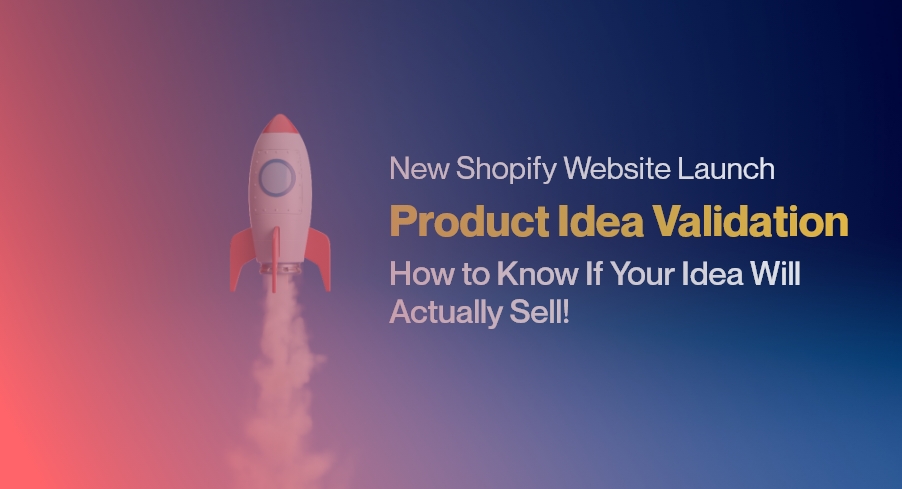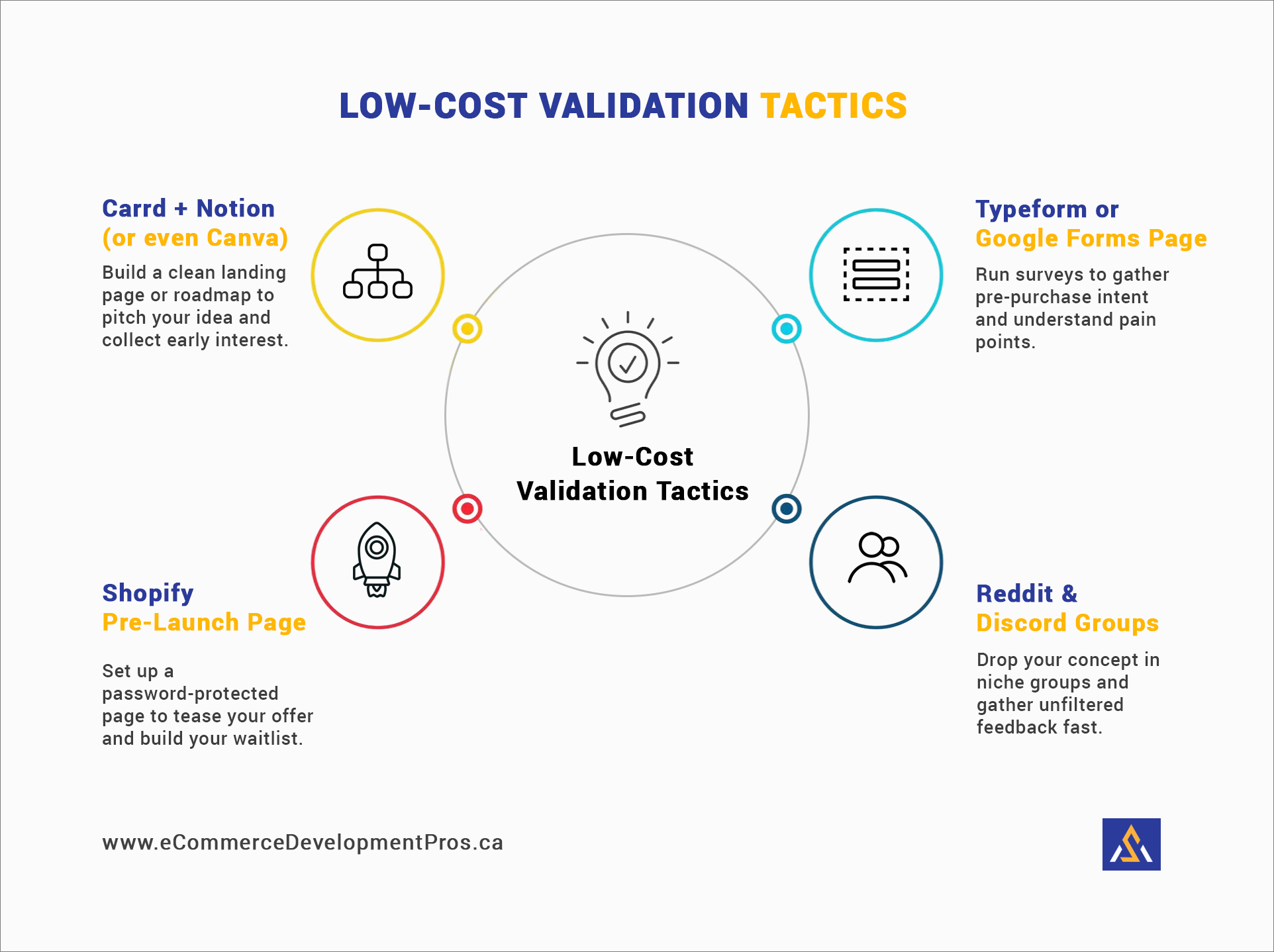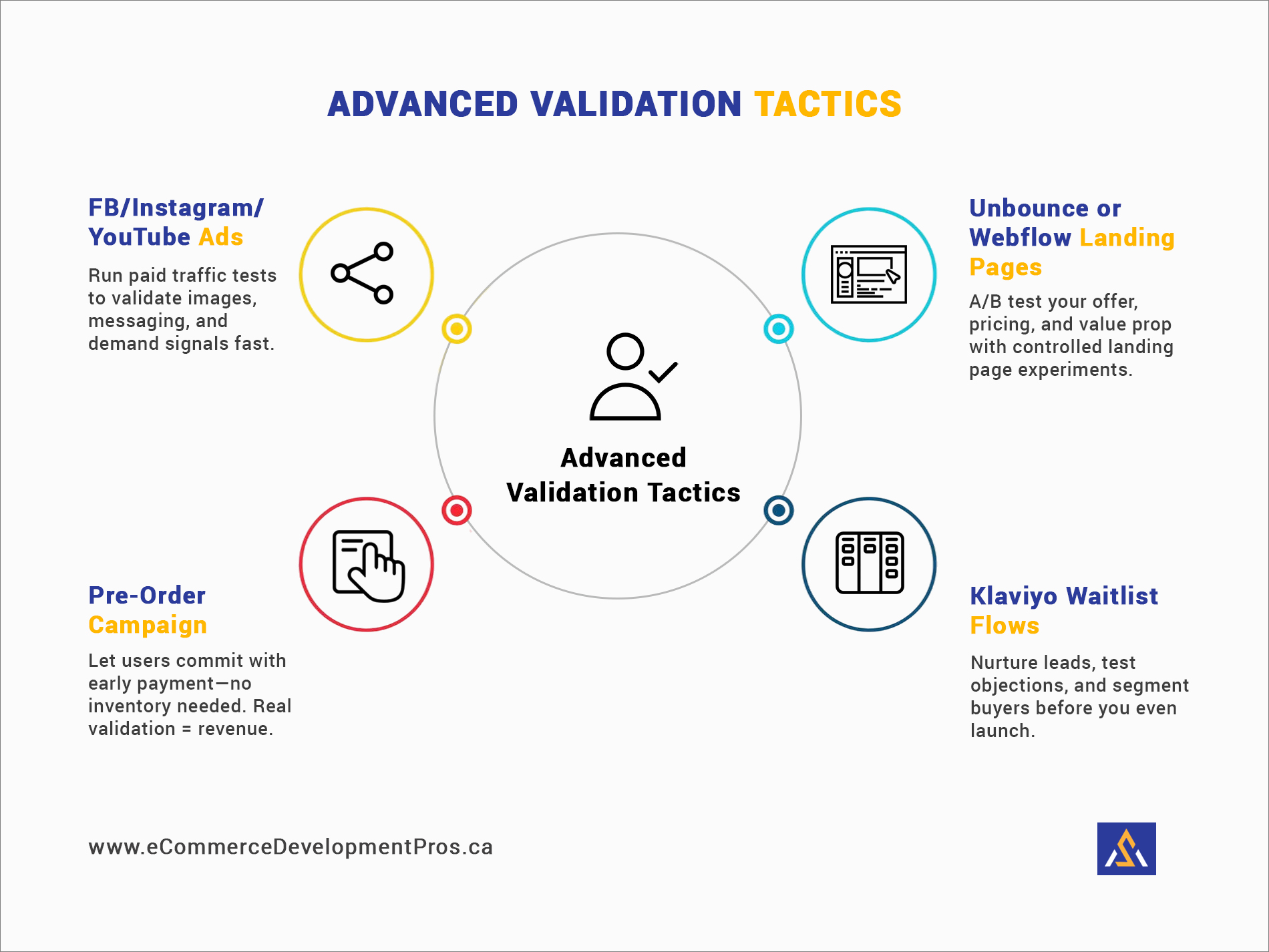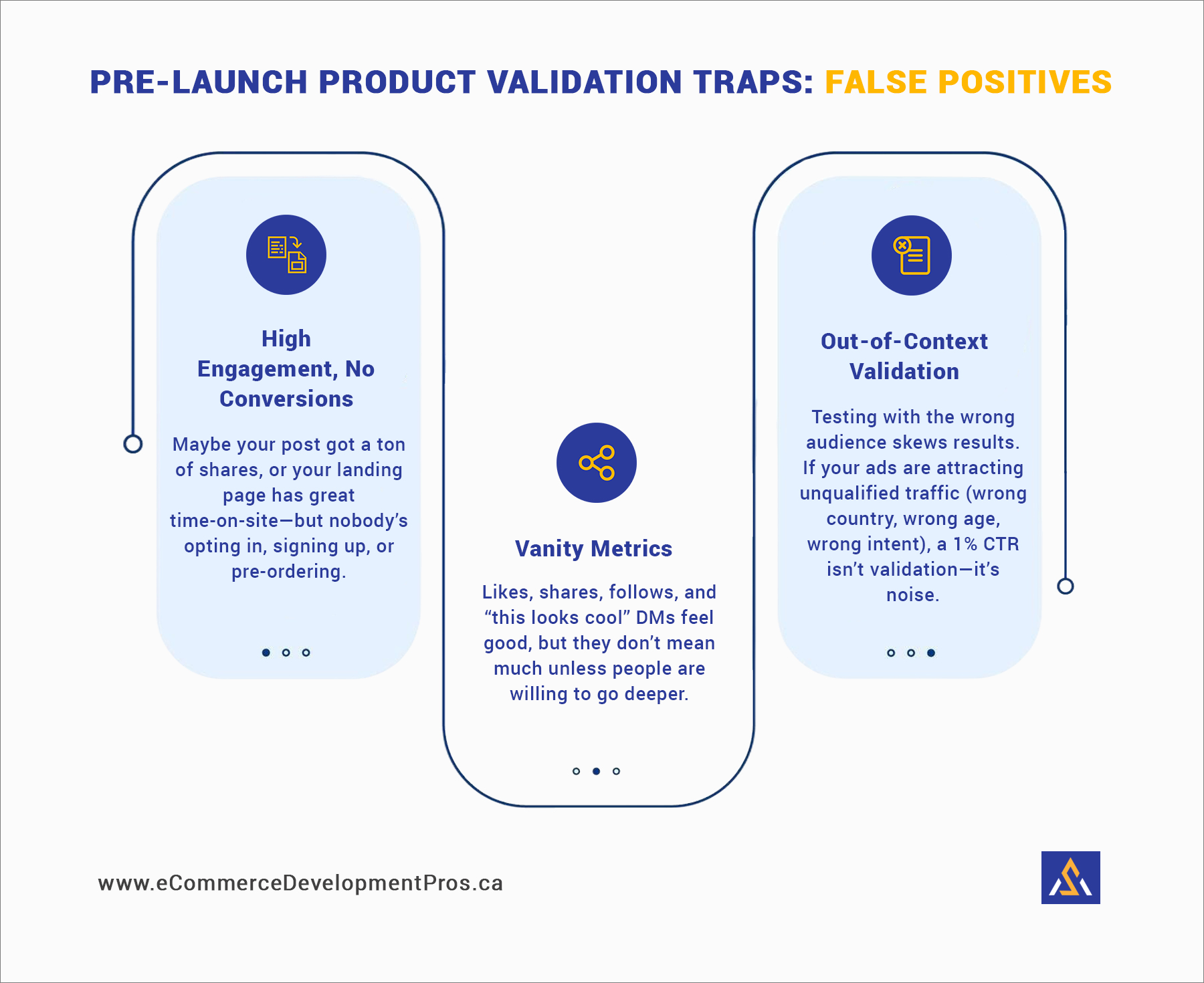- 🎯 Is This Post for You? Read This First.
- Why Most Shopify Launches Fail (And How Yours Won’t)
- Understanding Product Validation
- Product Idea Validation - The Signal Stack Framework
- Product Validation Tactics and Tools
- Product Idea Validation Case Studies: Real-World Examples
- Assessing Product Idea Validation Results: Are You Ready to Launch?
- Don’t Skip the Proof
- 🚀 Next Steps: Your Shopify Product Validation Action List

🎯This Is for eCommerce Founders Who Don’t Want to Guess.
If you’re building a Shopify store around a new product idea, this post might just save you from a painful, expensive flop.
Here’s the truth: most eCommerce launches fail because people skip Shopify product validation. They fall in love with the product, assume demand, and go straight to build mode. Then reality hits—and it’s quiet.
This guide is for you if:
- You’re in the pre-launch phase and want more than a “let’s see what happens” strategy backed by real product concept validation.
- You’re growing a DTC brand and want to validate product ideas before investing in inventory, design, or ads.
- You’re part of an agency or growth team, helping brands de-risk their next launch with proper eCommerce product research.
- Or maybe you’ve been here before—launched something you thought people wanted, only to hear… nothing.
If any of that hits home, you’re in the right room. What follows isn’t theory. It’s a practical pre-launch product validation playbook to help you test smarter, launch cleaner, and sell faster—with proof in hand.
Why Most Shopify Launches Fail (And How Yours Won’t)
Every product idea is a hypothesis.
That might feel weird to hear, especially if you’re already in love with your idea. But here’s the hard truth: until people pay you (or at least signal serious intent), your idea is just that — an idea.
And in the Shopify world, launching a product is easier than ever. The real challenge? Make sure you’re building something people actually want before sinking time, money, and energy into a full-blown store.
That’s where Shopify product validation comes in. This isn’t about vague “gut feelings” or friendly feedback. It’s about creating real-world signals that your product has legs.
In this post, I’ll show you exactly how to validate your product idea using a framework we call the Signal Stack, along with free and paid tactics, examples from DTC brands, and a no-fluff scorecard for knowing when you’re ready to launch.
Let’s dive in.
Understanding Product Validation
Before we go tactical, let’s get clear on the strategy.
Product concept validation is about answering one core question:
- Will people actually buy this product?
That’s different from:
- Customer validation – Am I targeting the right people?
- Market validation – Is the broader market worth entering?
While all three matter, shopify product validation is your first gate. You’re looking for data-backed eCommerce product research that proves your specific offer resonates before you spend a dollar on inventory or build out a Shopify store.
💡 Spoiler: Validation isn’t your friends telling you it’s “cool.” It’s email signups, landing page opt-ins, pre-orders, and people voting with their wallets.
Product Idea Validation - The Signal Stack Framework
Let’s talk about one of the most overlooked truths in early-stage eCommerce: product idea validation isn’t binary. It’s not a yes-or-no decision, and it’s definitely not a gut call based on a few DMs or some “likes” on a teaser post.
That’s why we use what we call the Signal Stack — a layered validation framework designed to capture meaningful, directional proof that your idea has traction.
Why a Stack?
Because no single signal is trustworthy in isolation.
- Likes can be flattering but meaningless.
- A high CTR doesn’t always equal strong purchase intent.
- And just because someone signed up doesn’t mean they’ll buy.
The Signal Stack helps you look at product market fit holistically—layering engagement, conversion, qualitative feedback, and post-interaction behavior to form a 360° view of whether your idea is truly validated.
Let me break it down for you:
🔹 Engagement Metrics
Are people interacting with your early concepts—even if they’re not buying yet?
This is your first sign of interest. When people land on your MVP landing page, what do they do?
Monitor the following metrics:
- Time on page: Are they spending time reading your offer?
- Scroll depth: Are they reaching the CTA or bouncing early?
- Bounce rate: Do they leave immediately?
- Social shares or saves: Do they think it’s worth sharing?
These indicators suggest that someone finds your idea at least intriguing—but they’re not enough on their own. Treat them as soft signals.
📌 Think of engagement as “curiosity.” It’s the top of the MVP for the Shopify store validation funnel.
🔹 Conversion Indicators
Are they taking tangible action that suggests intent?
This is where validation gets real. A user who hands over their email, joins a waitlist, or hits “add to cart” is showing clearer buying behavior.
Conversion signals include:
- Email opt-ins for early access
- Waitlist signups (with or without incentives)
- Pre-orders (even if you’re not shipping yet)
- Product quiz completions with an opt-in
- Cart additions or checkout starts (even without a final purchase)
The more friction involved—and the more they’re still willing to act—the stronger the signal.
📌 A conversion is someone “voting” for your product with time, data, or money. These are essential to test product demand online strategies.
🔹 Qualitative Feedback
What are people saying—and how are they saying it?
This layer fuels customer validation strategies that go beyond the numbers.
Sometimes, the richest insights come not from data dashboards but from direct feedback loops.
Ways to collect and decode qualitative signals:
- Open-form surveys (“What would make this a must-buy?”)
- Instagram DMs and email replies with emotional language
- Community reactions on Reddit, Discord, or Facebook groups
- Objections and questions (“Does this come in a larger size?”) = purchase intent cues
- “This sounds like me” moments – when someone self-identifies with your product’s positioning
Look for patterns.
- Are people confused about the offer?
- Are they excited?
- Are they asking the same questions repeatedly?
That’s all signal.
📌 Feedback helps you uncover why people are (or aren’t) converting—and how to tweak messaging, product, or price.
🔹 Bonus Layer: Retargeting & Price Tests
- Are people returning?
- Are they price-sensitive?
- Are they ghosting after checkout?
This layer is all about post-touch behavior—what happens after the first visit.
How to track it:
- Retargeting audiences: High return visitor % = deeper interest
- Cart abandon data: Did they hesitate at shipping? Price? Options?
- Price sensitivity tests: Run A/B landing pages with different pricing or offers
- Time between touches: Do they revisit 2–3 days later? That’s a strong signal.
🚨 One Signal Is a Maybe. A Stack Is a Green Light.
This is where most product ideas go wrong. Founders see one encouraging signal and sprint toward launch. But:
- High engagement + no opt-ins = not validated
- High opt-ins + terrible pre-order rate = needs refining
- Glowing feedback but no conversions = vanity traction
You’re looking for alignment. Multiple signals from different layers—interest, intent, feedback, behavior—all pointing in the same direction.
That’s when you know it’s go time.
Product Validation Tactics and Tools
At this point, you know what signals to look for – engagement, conversion, feedback, and behavioral proof.
Now, let’s talk about how to generate those signals to validate your product idea.
The tactics below are split into low-cost (lean and scrappy) and advanced (fast and scalable).
Both are effective; the difference is how quickly and deeply they generate insight.
💸 Low-Cost Validation Tactics
For early-stage MVP for Shopify store testing, simplicity wins.
You don’t need a dev team or a big ad budget to validate a product idea. Some of the best signals come from creatively using the no-code tool stack and tapping into existing communities.
Here are tried-and-tested validation strategies that cost almost nothing but give you clarity:
🛠️ Carrd + Notion (or even Canva)
Create a clean, branded landing page or product roadmap.
- Position your idea with a headline, subtext, and CTA (e.g., “Join the Waitlist”)
- Link it to a form or email capture
- Add mockups, benefits, or a short product explainer
Why it works: It feels real to the visitor. If they act on it, they’re validating the offer, not the tech behind it.
📝 Typeform or Google Forms
Run surveys to gather pre-purchase intent and understand pain points.
- Ask: “What’s the biggest frustration you have with [product category]?”
- Or: “Would you be interested in a product that does X?”
💡 Pro tip: Add a question like, “Would you like to be notified if we build this?” → Build your early list on the spot.
🛍️ Shopify Pre-Launch Page
- Build a minimal homepage or product page with a compelling description
- Add an email signup form as the “CTA.”
- Use it as a soft-launch or teaser campaign
💡 This approach gives the impression that something is coming—urgency and exclusivity help generate opt-ins.
💬 Reddit & Discord Groups
Find niche audiences and float your idea in the right subreddits or Discord channels.
- Be transparent: “Thinking of launching [X], curious if this solves a pain point.”
- Include mockups, visuals, or links to your MVP site
- Read comments carefully— objections = insights
💡 Bonus Tactic: Run a poll: “Which product would you buy?”
This simple prompt helps test positioning, price points, and emotional pull.
💰 Advanced Validation Tactics
Ready to invest some budget behind your hypothesis?
The following tools and strategies support high-signal product concept validation.
📱 FB/Instagram/YouTube Ads
Use paid traffic to test visuals, headlines, and offers.
- Create ad variations that target your ideal customer persona (ICP)
- Drive traffic to a landing page (even if it’s just to collect emails)
- Measure CTR, CPC, and opt-in rate to assess product-market interest
💡 Pro tip: The image/headline combo with the highest CTR tells you what messaging resonates most.
🧪 Unbounce or Webflow Landing Pages
A/B test headlines, product benefits, pricing, and CTAs.
- Example: “Try Product A for $10” vs “Try Product A Risk-Free for 30 Days”
- Track conversion rate across variants
- Use tools like Google Optimize for basic split testing, or go deeper with VWO or Convert.
🛒 Pre-Order Campaigns
Create urgency and validate intent by asking users to put money down, even if you haven’t manufactured yet.
- Offer a limited-time discount or early bird bundle
- Communicate clearly about timelines and fulfillment
Nothing beats money-in-hand for validation. Even a 3–5% conversion rate from cold traffic is gold.
🔄 Klaviyo Waitlist Flows
Use email to warm leads, measure interest, and test objections.
- Set up a 3-part sequence after someone joins your waitlist
- Include surveys, exclusive content, or “choose your version” polls
Use segmentation to gauge who’s really ready to buy.
🧠 Don’t Forget Behavioral Analytics
Regardless of which tactic you choose, install behavioral tracking.
Use tools like:
These tools let you:
- Watch scroll and click heatmaps
- Identify rage clicks or exit points
- Analyze how far users get before bouncing
Use these tools to test product demand online with measurable, repeatable outcomes.
Product Idea Validation Case Studies: Real-World Examples
It’s one thing to talk about validation frameworks. It’s another to see them in motion. Below are a few validation case studies that illustrate how smart DTC brands—big and small—put their ideas to the test before fully launching.
None of them relied on luck. All of them focused on real signals—and it made all the difference.
🧃 OLIPOP’s Flavor Expansion: Listening Before Launching
OLIPOP, the fast-growing functional soda brand, didn’t just drop new SKUs and hope for the best. Before expanding their product line, they turned to their most valuable resource: their own customers.
How they validated:
- Sent out email polls to their existing subscriber list
- Asked customers to vote on upcoming flavor options
- Encouraged open-ended write-ins and feedback
What they got:
- Thousands of responses
- Clear quantitative data on which flavors were most desirable
- Qualitative insights that helped with naming, messaging, and even packaging
Why it worked:
They weren’t asking strangers on the internet. They used customer validation strategies and tapped into a loyal community already engaged with the brand. The feedback loop was immediate, authentic, and actionable.
🔁 Takeaway: If you’ve already got an audience—even a small one—they’re your testing ground. Don’t guess. Ask.
👟 Sneaker Startup (Anonymous): Battle of the Styles
A lean, early-stage DTC sneaker brand wanted to launch a new silhouette but wasn’t sure which design would resonate best. Instead of investing in production, they ran a quick, low-cost validation experiment.
How they validated their product idea:
- Spent $500 on Instagram Story ads targeting sneakerheads
- Created a simple poll: Style A or Style B?
- Tracked not just votes but swipe-ups and email signups tied to each design
What they got:
- Clear winner in terms of engagement and opt-ins
- The winning design converted 3X higher post-launch than the alternative
- Feedback helped refine the story and positioning for the product
Why it worked:
They used paid traffic not to sell but to learn (a smart product concept validation strategy). Every click and vote was a real-time market signal, letting them commit to a direction with confidence.
🧠 Takeaway: Paid ads aren’t just for selling—they’re a rapid-fire feedback machine for early validation.
🕯️ Candle Brand: Building Demand Before Inventory
One boutique candle brand didn’t wait to stock up before testing demand. Instead, they went scrappy and strategic with a landing page + pre-order combo.
How they validated:
- Built a clean, one-page Carrd site with high-quality product mockups
- Offered a 20% discount on pre-orders
- Set a public goal: “Help us reach 500 signups before we launch!”
What they got:
- 637 pre-order signups in just 6 days
- Built an engaged email list and community before shipping a single product
- Used that momentum to secure better pricing from suppliers
Why it worked:
- They made the product feel real—even though it didn’t exist yet. By framing it as an early-access launch, they created urgency and FOMO without the risk of unsold inventory. This is pre-launch product validation done right.
🔥 Takeaway: You don’t need a product to validate—you need a promise people believe in and a way to measure how many raise their hand.
✅ The Common Thread
Each of these brands used simple tactics—polls, landing pages, low-budget ads—but paired them with the right mindset:
- They measured.
- They iterated.
- They didn’t wait until launch to listen.
This is the validation mindset. And it’s how you build a product that actually sells on Shopify or anywhere else. A strong product validation framework.
Assessing Product Idea Validation Results: Are You Ready to Launch?
So, you’ve launched your landing page, pushed out some ads, collected emails, and maybe even pre-orders. But here’s the real question:
How do you know when you’ve validated your product enough to go from “idea” to “build”?
Too many DTC founders either:
- Pull the trigger too early (based on hype, not proof), or
- Stay stuck in validation limbo, always testing, never building.
Let’s fix that with a clear, flexible framework to help you decide when you’re truly ready to move forward – with everything from eCommerce product research to launch.
📊 Your Validation Benchmark Cheat Sheet
Every product and niche is a little different, but here are some battle-tested benchmarks that signal strong early traction:
| Metric | What It Measures | Threshold |
|---|---|---|
| Email Opt-in Rate | Interest in offer | > 25% = strong signal |
| Click-Through Rate (CTR) | Resonance of messaging (ads) | > 1% = meaningful traction |
| Pre-order Conversion Rate | Purchase intent under friction | > 5% = solid green light |
| Landing Page Bounce Rate | Message clarity & fit | < 55% =compelling story |
These are not arbitrary numbers—they reflect patterns observed in successful MVP for Shopify store launches and real-world product market fit journeys.
If you’re consistently hitting (or exceeding) these numbers—especially across multiple signals in your Signal Stack—you’re probably ready to build, launch, and scale.
But validation isn’t just about numbers. It’s also about pattern recognition, context, and avoiding false positives.
🚨 Beware of Pre-Launch Product Validation Traps: False Positives
Here’s where a lot of product ideas get misleading “go” signals that turn into dud launches. You’ll want to avoid these traps:
❌ High Engagement, No Conversions
Maybe your post got a ton of shares, or your landing page has great time-on-site—but nobody’s opting in, signing up, or pre-ordering.
That’s a red flag.
Why it happens:
- The product might be entertaining but not needed
- Messaging may resonate emotionally but not practically
- The offer isn’t compelling or clear
❌ Vanity Metrics
Likes, shares, follows, and “this looks cool” DMs feel good, but they don’t mean much unless people are willing to go deeper.
What to do instead:
- Measure actions, not applause
- Prioritize opt-ins, waitlists, purchases, and deep survey responses
❌ Out-of-Context Validation
Testing with the wrong audience skews results. If your ads are attracting unqualified traffic (wrong country, wrong age, wrong intent), a 1% CTR isn’t validation—it’s noise.
These are classic traps in test product demand online experiments—look past the noise and trust multi-layered signals.
💡 Pro tip: Always double-check who your signals are coming from—not just what they are.
🚀 Traction Triggers: When to Move Forward
We use the term “Traction Triggers” to describe the early, measurable signs that your product has the momentum it needs.
Here’s what solid shopify product validation looks like in action:
- 300+ waitlist signups in 7 days
- 10% of survey respondents opting into a preorder
- Positive feedback that echoes across channels – “This is exactly what I’ve been looking for.”
- Returning visitors checking your offer more than once
- Steady pre-orders without pushing discounts
The key is not just volume but consistency across your validation stack.
One spike?
- Interesting.
Sustained traction across signals?
- That’s your green light. 🟢
✅ Final Gut Check
Ask yourself:
- Are multiple validation layers pointing in the same direction?
- Is there enough data to reduce launch risk significantly?
- Can I confidently explain why my product will sell based on what real people did, not just what I think?
If the answer is yes:
- It’s time to build
If the answer is “sort of:
- Don’t panic—adjust your messaging, refine your offer, or test a new channel. Iterate; don’t guess.
This is how the smartest brands validate. They don’t guess. They validate product ideas, learn quickly, and pivot before the stakes get high.
Don’t Skip the Proof
If you’re in eCommerce, here’s a reality check worth taping to your computer:
- The fastest way to burn cash is to build first and validate later.
It’s tempting to jump straight into production, packaging, and Shopify themes. After all, building feels like progress. It’s exciting. It’s tangible.
But if you’re building based on assumptions, you’re not growing a brand—you’re gambling.
The DTC brands that scale smart? They don’t guess.
They invest in product validation before they build.
They:
- Stack real-world signals
- Measure traction in the wild
- Learn from their market before investing in inventory
By the time they flip the switch and launch, they’re not hoping for demand—they’re riding a wave they already saw forming.
🛑 So if you’re about to launch, pause and ask:
- What proof do I have that people will buy this?
Not what you believe. Not what your best friend said.
What actual proof lives in your data, your feedback, and your traction stack?
- If that proof is clear, layered, and consistent, go build it.
- If not? Don’t panic.
Go back to your Signal Stack. Refine your message. Test your offer. Talk to real people.
Because product ideas are cheap.
Validated products?
Those are the ones that scale.
Next Steps: Your Shopify Product Validation Action List 🚀
- Choose a product idea or variant you want to validate first—don’t try to test everything at once.
- Set up your Signal Stack:
- A landing page (Carrd or Shopify)
- Opt-in form (Klaviyo, Typeform, etc.)
- Behavioral tracking (Hotjar, Lucky Orange)
- Pick 1–2 low-cost tactics and 1 paid channel to start testing.
- Define your validation benchmarks (opt-in %, CTR, bounce rate, etc.)
- Run the experiment for at least 5–7 days with a clear CTA and goal.
- Analyze your traction triggers: Are signals stacking up across engagement, conversion, and feedback?
- Decide: Build it, tweak it, or test another idea.
- Repeat or scale up based on your results.
Don’t just read and nod—ship the test.







